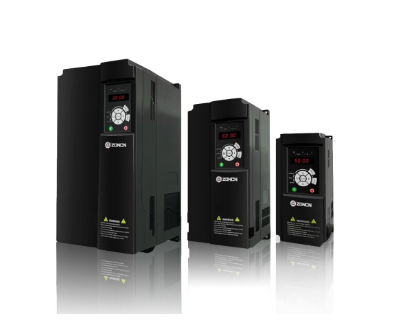Inverter mainly consists of rectification (AC to DC), filtering, inversion (DC to AC), braking unit, drive unit, detection unit microprocessor unit, etc. Through the internal IGBT disconnection, the inverter can adjust the voltage and frequency of the output power supply, and provide the required power supply voltage according to the actual needs of the motor, so as to achieve the purpose of energy saving and speed regulation. In addition, the inverter also has a variety of protection functions, such as overcurrent, overvoltage, overload protection, etc., to ensure the safe operation of the motor.
Working principle of inverter:
The working principle of the inverter mainly involves two parts: control circuit and main circuit. The rectifier in the main circuit converts AC into DC, the DC intermediate circuit smoothes and filters the DC, and then the inverter converts the DC into AC with the required frequency and voltage. Some inverters will also add components such as CPU in the circuit to perform necessary torque calculations. The working principle of the inverter is mainly to control the speed of the motor by changing the frequency of the power supply, so as to achieve the purpose of adjusting the operation of the motor.
With the continuous improvement of the degree of industrial automation, inverters have been widely used. It can be applied to various occasions that require speed regulation, such as frequency conversion energy saving, automation system, improving process level and product quality, realizing motor soft start, etc. In addition, the frequency converter can also be used in various motor control systems, such as CNC machine tools, elevators, air conditioners, etc.
The technical parameters of the inverter mainly include the following aspects:
Voltage level: The input and output voltage levels of the inverter may vary depending on the model and application scenario. Common ones include single-phase 220V, three-phase 380V, three-phase 660V, etc.
Rated power: The rated output power of the inverter, usually in kilowatts (kW) or horsepower (HP).
Input frequency: The input frequency of the inverter may vary depending on different applications. Common ones are 50Hz and 60Hz.
Output frequency: The output frequency of the inverter can be adjusted as needed, usually ranging from 0Hz to the power frequency.
Frequency accuracy: The frequency accuracy of the inverter usually refers to the stability and accuracy of its output frequency, usually between ±0.1Hz and ±1.0Hz.
Control accuracy: Control accuracy is an important parameter to measure the control performance of the inverter, usually expressed as a percentage, ranging from ±0.5% to ±2%.
Response time: The response speed of the inverter to the input signal, that is, the time from receiving the control signal to generating the corresponding voltage and frequency at the output end.
Overload and protection capacity: The short-term overload capacity that the inverter can withstand, usually expressed as a multiple of the rated power. The safety protection functions of the inverter include overcurrent protection, overvoltage protection, undervoltage protection, overload protection, etc.
Control mode: The control mode of the inverter can be open-loop control or closed-loop control, and can also support various control algorithms and interfaces.
Environmental conditions: The working environment conditions applicable to the inverter, including temperature range, humidity range, altitude limit, etc. These conditions have a great impact on the performance and reliability of the inverter.
Dimensions and installation method: The dimensions, installation method and installation requirements of the inverter to ensure compatibility with existing equipment or systems and meet safety standards.
Application scenarios of frequency converters:
The application scenarios of frequency converters are very wide. Frequency converters are widely used in the field of industrial automation, such as CNC machine tools, printing machinery, packaging machinery, elevators, textile machinery, etc. In these occasions, frequency converters can be used to control the speed and power of motors to achieve automated production and improve production efficiency.
Frequency converters are also widely used in the fields of energy and electricity, such as wind power generation, hydropower generation, thermal power generation, etc. In these occasions, frequency converters can be used to control the speed of motors and pumps to achieve efficient use of energy and stable output of electricity. Frequency converters are also widely used in the field of transportation, such as subways, light rail, EMUs, elevators, etc. In these occasions, frequency converters can be used to control the speed and traction of motors to achieve safe operation of vehicles and energy conservation and emission reduction.
Power inverters are also widely used in the field of municipal engineering, such as pumping stations, sewage treatment plants, fire protection systems, etc. In these occasions, frequency converters can be used to control the speed and flow of motors to achieve normal operation of municipal engineering and energy conservation and emission reduction. The application of frequency converters in commercial and household fields is also gradually popularized, such as air conditioners, water pumps, fans, refrigerators and other occasions. In these occasions, frequency converters can be used to control the speed and power of motors to achieve energy-saving operation and comfort of equipment. The application range of frequency converters is very wide, and they can be applied to various occasions that require speed regulation and motor control. By reasonably selecting and using frequency converters, the performance and reliability of equipment can be improved, and energy conservation, emission reduction and safe production can be achieved.
In short, frequency converters are an important power control device that controls the operation of AC motors by changing the frequency of the motor’s working power supply. Its working principle mainly involves two parts: the control circuit and the main circuit. The voltage and frequency of the output power supply are adjusted by the opening and closing of the internal IGBT to achieve the purpose of energy saving and speed regulation. With the continuous improvement of the degree of industrial automation, the application range of frequency converters is becoming more and more extensive.


